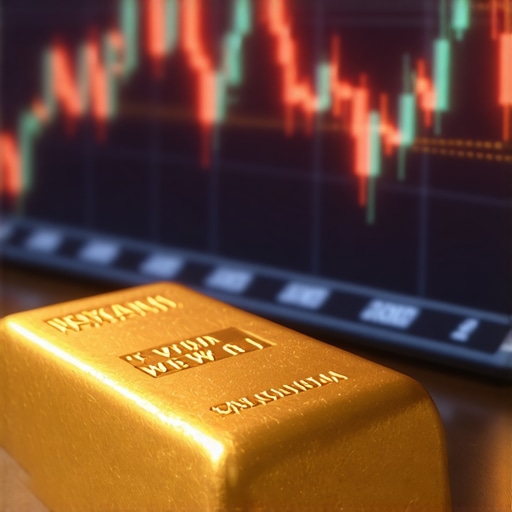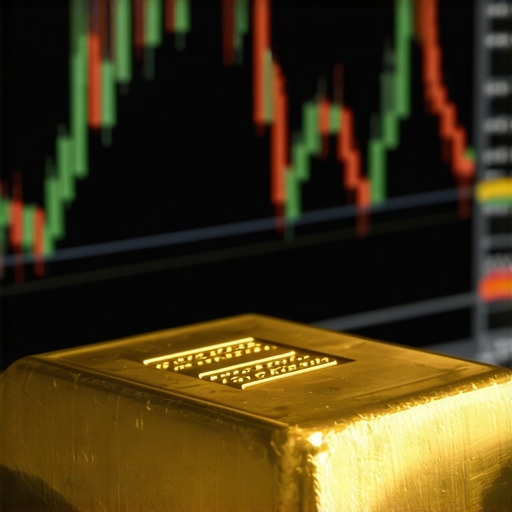Understanding Gold Price Trends and Future Predictions
The gold market has always been a fascinating area for investors, especially when it comes to forecasting prices for the coming year. With the fluctuating nature of global economies and the ongoing geopolitical tensions, understanding how gold prices are influenced is crucial for making informed investment decisions. In this article, we will explore the factors that could shape the gold price forecast and what investors should expect in the near future.
Key Influencers of Gold Prices
Several factors play a significant role in determining gold prices. These include economic conditions, inflation rates, and market demand. For instance, during periods of economic uncertainty, investors tend to flock to gold as a safe-haven asset, driving its price up. Moreover, inflation can erode the purchasing power of currency, making gold an attractive investment to preserve wealth.
The impact of inflation on gold prices is particularly noteworthy. As inflation rates rise, the demand for gold typically increases, as it is viewed as a hedge against inflation. This trend has been observed in past economic cycles, and many analysts expect it to continue in the coming year.
Global Events and Their Impact
Global events, such as political instability and economic downturns, can also significantly influence gold prices. For example, recent conflicts or changes in government policies can lead to market volatility, prompting investors to seek the stability offered by gold. Understanding these dynamics is essential for predicting future price movements.
Furthermore, factors such as central bank policies and interest rates cannot be overlooked. Central banks hold substantial gold reserves, and their buying or selling actions can directly impact market prices. Monitoring central bank purchases can provide valuable insights into potential price trends.
Expert Insights and Predictions
Market analysts and experts often provide forecasts based on comprehensive data analysis. For the upcoming year, many are optimistic about gold’s performance, citing strong demand from both investors and industries. The ongoing uncertainty surrounding global markets may further bolster gold’s appeal.
In conclusion, while predicting gold prices is inherently challenging due to the multitude of influencing factors, staying informed about economic trends, geopolitical developments, and market demands can assist investors in making educated decisions. For those looking to invest, it’s essential to keep abreast of the latest news and analysis, as these elements will shape the gold price forecast in the coming year.
Analyzing Gold Demand Trends for Future Investments
A comprehensive understanding of gold demand trends is essential for investors looking to navigate the complexities of the market. The gold demand trends are influenced by various factors, including jewelry consumption, industrial applications, and investment demand. In recent years, we’ve seen fluctuations in these areas, which can directly affect the prices of gold.
Jewelry Demand and Cultural Influences
Jewelry remains one of the largest segments of gold demand, especially in countries like India and China, where cultural traditions play a significant role. Festivals, weddings, and other celebrations drive the demand for gold jewelry, impacting overall market prices. Understanding these cultural dynamics can help investors make informed predictions about future price movements.
Investment Demand: The Role of Gold ETFs
Another critical aspect of gold demand is investment. Gold Exchange-Traded Funds (ETFs) have become increasingly popular among investors seeking exposure to gold without the hassle of physical ownership. The rise of gold ETFs allows investors to buy and sell gold shares easily, which can influence demand and, in turn, prices. As more investors flock to these financial products, the overall demand for gold may increase, leading to potential price hikes.
Industrial Applications and Technological Advancements
Gold is also utilized in various industrial applications, including electronics and dentistry. As technology continues to evolve, the demand for gold in these sectors may rise, further contributing to the overall demand trends. Investors should keep an eye on advancements in technology that might increase gold’s industrial usage, thereby impacting its market value.
Central Bank Policies and Gold Investments
Central banks play a crucial role in the gold market. Their buying and selling activities can significantly influence gold prices. Recently, many central banks have increased their gold reserves, signaling a bullish outlook on gold as a stable asset. Monitoring central bank policies can provide insights into potential future price trends and investor sentiment.
Economic Indicators and Their Influence on Gold Prices
Economic indicators such as GDP growth, unemployment rates, and inflation data also affect gold prices. For instance, if inflation rates rise, investors often turn to gold as a hedge, driving demand and prices higher. Keeping track of these economic indicators can help investors anticipate shifts in the gold market.
Global Economic Stability and Its Effect on Gold
The overall stability of global economies can significantly impact gold prices. During times of economic uncertainty or geopolitical tensions, gold usually sees an uptick in demand as investors seek safe-haven assets. Understanding the relationship between economic stability and gold demand can aid investors in making strategic decisions about their portfolios.
In conclusion, the interplay of various factors, including cultural influences, investment demand, industrial applications, central bank activities, and economic indicators, creates a complex landscape for gold prices. Investors must remain vigilant and informed about these dynamics to make well-informed decisions regarding their gold investments. As we look ahead to 2025, staying updated on these trends will be crucial for maximizing returns and navigating the gold market effectively.
Investment Strategies for Gold: Adapting to Market Trends
In light of shifting gold demand trends, investors must adapt their strategies to effectively navigate the market. Understanding how various factors influence gold prices enables investors to make informed decisions. For example, as the demand for gold jewelry fluctuates, so too does the investment landscape. Investors might consider diversifying their portfolios with products like gold ETFs or physical gold to mitigate risks associated with market volatility.
Utilizing Gold ETFs for Strategic Investment
Gold ETFs have gained traction as a flexible investment option, allowing investors to gain exposure to gold without the need for physical storage. These funds track the price of gold and offer a convenient way to invest in this precious metal. As the popularity of these funds continues to rise, understanding their operational mechanics and benefits is essential. Investors can leverage gold ETFs to hedge against inflation and currency fluctuations, making them a vital component of a well-rounded investment strategy.
Physical Gold vs. Digital Assets: Making Informed Choices
When considering gold investments, one must weigh the benefits of physical gold against digital assets such as ETFs and cryptocurrencies. Physical gold, including coins and bullion, offers a tangible asset that can provide security during economic downturns. In contrast, digital assets can be more liquid and accessible, appealing to tech-savvy investors. A comprehensive understanding of both forms can guide investors in choosing the option that best aligns with their financial goals.
Emerging Market Trends and Gold Investments
As we move further into the decade, emerging market trends play a significant role in shaping gold demand. Countries with burgeoning middle classes, such as India and China, are expected to see increased jewelry consumption, which will drive demand for gold. Keeping an eye on these trends is crucial for investors looking to capitalize on future opportunities in the gold market.
Gold as a Hedge Against Economic Uncertainty
Historically, gold has been viewed as a safe-haven asset during times of economic uncertainty. Investors often flock to gold during market downturns or geopolitical turmoil, driving demand and prices higher. Thus, incorporating gold into an investment portfolio can serve as a protective measure against unforeseen economic events. Understanding the psychological factors that drive investors to gold during crises is essential for anticipating market movements.
Global Events and Their Impact on Gold Pricing
Global events, such as political instability and economic sanctions, can significantly influence gold prices. For instance, when tensions rise in key regions, investors may seek refuge in gold, pushing prices upwards. Staying informed about current events and their potential impact on gold can help investors make timely decisions. Following reliable financial news sources and market analysis can keep investors updated on trends and fluctuations.
Future Considerations: The Role of Technology in Gold Trading
As technology continues to evolve, its impact on gold trading cannot be overlooked. Innovations such as blockchain technology are beginning to reshape how gold is bought and sold, offering increased transparency and security. These advancements may also lower transaction costs and make gold trading more accessible to everyday investors. Embracing technology in gold trading can provide competitive advantages and enhance investment strategies.
In summary, comprehensively analyzing gold demand trends and understanding their implications on investment strategies is vital for maximizing returns in the gold market. By keeping abreast of market developments, economic indicators, and technological advancements, investors can position themselves for success in a dynamic environment. With an informed approach to gold investments, individuals can navigate the complexities of the market effectively and enhance their financial well-being.
Analyzing Gold Demand Trends: Future Insights for Investors
As the global economy continues to evolve, understanding gold demand trends becomes increasingly vital for investors. In particular, the rise of emerging economies and shifting consumer preferences are reshaping the gold market landscape. Investors who remain attuned to these changes can better position themselves for success in a fluctuating market.
The Influence of Economic Growth on Gold Consumption
Economic expansion in developing nations, such as India and China, is significantly impacting gold consumption patterns. As these countries experience a growing middle class, the demand for gold jewelry and investment products is on the rise. This surge is not only a reflection of cultural significance but also of the desire for wealth preservation among these populations. Investors should monitor economic indicators in these regions to identify potential shifts in gold demand.
The Role of Central Banks in Shaping Gold Prices
Central banks play a crucial role in influencing gold prices. Their purchasing activities can create ripples throughout the market, affecting investor sentiment and pricing dynamics. For instance, when central banks increase their gold reserves, it often signals confidence in the asset as a stable store of value. Understanding the motivations behind central bank purchases can provide valuable insights into market trends and potential price movements. Investors can explore articles on how central bank purchases impact gold prices to deepen their understanding of this relationship.
Technological Innovations and Their Impact on Gold Trading
Technological advancements are transforming how investors approach gold trading. Innovations such as online trading platforms and blockchain technology are making it easier for individuals to buy and sell gold. These tools enhance transaction security and transparency, attracting a broader audience to the gold market. Investors should consider leveraging these technological developments to streamline their trading processes and improve their investment strategies.
Gold Trading Techniques for Today’s Investors
To maximize returns, investors must adopt effective gold trading techniques. Techniques such as technical analysis, market timing, and risk management strategies are essential for navigating price fluctuations. Understanding how to analyze gold price trends and employing strategic trading practices can help investors make informed decisions. For those new to the market, resources like essential guide to gold trading techniques for newbies can provide invaluable insights.
Investment Diversification: The Key to Risk Management
Diversifying investments is a fundamental strategy for minimizing risks associated with market volatility. Including gold in a diversified portfolio can enhance overall performance and provide a hedge against economic downturns. Investors should explore various gold products, such as physical gold, ETFs, and mining stocks, to find the right balance for their investment goals. This approach allows for flexibility and adaptability in response to changing market conditions.
Conclusion: Staying Ahead in the Gold Market
In conclusion, understanding gold demand trends and leveraging technological advancements are essential for successful investing in the gold market. By keeping abreast of economic developments and adopting strategic trading techniques, investors can enhance their financial portfolios. As the market evolves, those who remain informed and adaptable will be better positioned to capitalize on the opportunities that arise in the dynamic world of gold investments.
Frequently Asked Questions about Gold Investment
What are the current trends in gold demand?
The current trends in gold demand reflect a significant increase in consumption from emerging markets, particularly in Asia. Additionally, the rise of inflation concerns and geopolitical tensions are driving investors toward gold as a safe-haven asset.
How do central bank policies affect gold prices?
Central banks can greatly influence gold prices through their buying and selling activities. When central banks purchase gold, it often leads to an increase in prices as demand rises. Conversely, selling can lead to price drops.
What are the benefits of investing in gold?
Investing in gold provides several benefits, including portfolio diversification, protection against inflation, and a hedge against economic uncertainty. Gold has historically maintained its value, making it a reliable investment choice.
How can I start trading gold?
To start trading gold, investors can explore various avenues such as physical gold purchases, gold exchange-traded funds (ETFs), or online trading platforms. It is crucial to conduct thorough research and understand the market dynamics before entering.
What strategies should I use for gold trading?
Effective gold trading techniques include employing technical analysis to identify price trends, utilizing stop-loss orders to manage risk, and staying informed about market news that may impact gold prices.
Is gold a good long-term investment?
Yes, many financial experts consider gold to be a good long-term investment due to its historical performance and ability to serve as a hedge against economic downturns. It tends to retain value over time, making it a stable asset.
What are the risks associated with gold investment?
Investing in gold does carry risks, including price volatility, market manipulation, and changes in demand due to economic factors. It’s essential to stay informed and implement risk management strategies.
How can I diversify my investment portfolio with gold?
To diversify your portfolio with gold, consider allocating a percentage of your investments to various gold-related assets, such as physical bullion, gold stocks, and ETFs. This approach can reduce overall risk while maintaining exposure to gold’s potential gains.
What is the impact of geopolitical events on gold prices?
Geopolitical events often lead to increased uncertainty in the markets, prompting investors to flock to gold as a safe-haven asset. This influx of demand typically results in higher gold prices during times of global unrest.
Where can I find reliable information about gold investment?
Reliable information about gold investment can be found on trusted financial news websites, investment platforms, and resources such as Reuters, Bloomberg, and Kitco. These platforms provide up-to-date market analyses and insights from industry experts.
Authority Resources for Gold Investment Insights
For those seeking further knowledge on gold investment, several trusted resources can enhance your understanding:
- World Gold Council – Provides comprehensive data and insights on gold demand and investment trends.
- Kitco News – Offers current news and analysis on gold prices and market trends.
- Reuters Commodities – Features in-depth coverage of gold and other precious metals.
- Bloomberg Markets – A reliable source for market updates on commodities, including gold.
- Investing.com – Provides market analysis, forecasts, and news on gold investments.
Conclusion: Embracing the Future of Gold Investments
In summary, understanding gold demand trends and leveraging technological advancements are crucial for investors looking to navigate the gold market effectively. By staying informed about economic developments, adopting strategic trading techniques, and utilizing authoritative resources, investors can enhance their portfolios in this dynamic landscape. As the market continues to evolve, those who remain adaptable and informed will better position themselves to seize opportunities in the fascinating world of gold investments.











The article does a superb job explaining the multifaceted influences on gold prices. I particularly found the connection between global geopolitical tensions and the demand for gold as a safe-haven asset to be very insightful. From my experience, during times of uncertainty, gold indeed becomes a go-to investment for many looking to stabilize their portfolios. However, one aspect that I think deserves more attention is how shifting central bank policies in emerging markets might impact global gold prices differently compared to traditional economies. For instance, increased gold purchases by central banks in countries like India or China could signal not only confidence in gold but also a strategic move to hedge against currency volatility specific to these regions. It makes me wonder how investors balance these regional influences with broader global economic signals when forecasting gold prices. Also, with the rise of gold ETFs making gold more accessible, do you think this will eventually diminish the demand for physical gold, or will cultural factors and industrial uses continue to underpin its importance? I’d love to hear how others approach integrating these varying factors into their investment strategies, especially in uncertain economic climates.